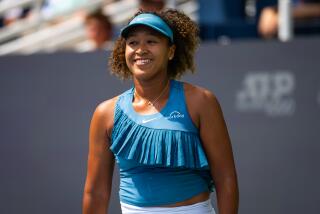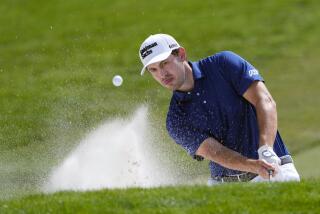TENNIS / JULIE CART : Absent Courier Sound of Body, but His Mind Lets Him Down
GOTHENBURG, Sweden — The problem is one of too little time off. U.S. Davis Cup captain Tom Gullikson was saying that’s what is keeping top tennis players off the court. And potential Davis Cup players out of uniform.
The discussion grew out of a simple question: Where was Jim Courier? Courier is one top American player who always is ready to play Davis Cup, who always makes room in his schedule to represent his country.
Gullikson’s point was interesting--Courier has been betrayed by his body. Because Courier is big and strong and fit, he’s rarely injured. That means he never takes time off the tour. That means he’s physically fit but mentally a wreck.
“Most of these guys take time off when their body cries out, ‘Help me, I need it,’ ” Gullikson said. “That’s how they end up taking time off. These guys don’t schedule rest into their schedule. They are either playing tournaments or exhibitions.”
Courier helped the United States pull out the Davis Cup quarterfinal against the Netherlands, but Gullikson understood when Courier declined an offer to play in this week’s semifinal against Sweden.
“He’s a little burned out right now,” Gullikson said. “He needs some time to rest and recharge his batteries. Jim’s done a great job this year with Davis Cup. He got the winning point against Holland. He just needed some time off. Jim’s a very intense player, and to play well he needs to be focused and energetic.”
*
Todd Martin is not injured. He merely looks that way. He takes the court with most major joints encased in blue neoprene. His knee looks like a sausage and there are untold yards of wrapping under his shorts to deal with a groin strain.
Bud Collins of the Boston Globe remarked that Martin looked like an extra from the cast of “The Mummy’s Curse,” but Martin called the gear precautionary .
“It’s just bumps and bruises I have to take care of,” Martin said. “I’m certainly not in 100% tip-top shape. But as long as the stuff doesn’t bother me on the court, and it might prevent something, I’m going to wear it.”
*
Martin was not among those surprised to learn that Russia’s Davis Cup team had gone 2-0 against the Germans on the first day of that semifinal.
“Tennis people have always known that the Russians are dangerous,” Martin said. “(Yevgeny) Kafelnikov is probably one of the best young players coming up. It’s just a matter of time before he gets into the top 10. The thing about the Russians is that they go after every shot. That makes them dangerous.”
Their doubles victory on Saturday gave the Russians an insurmountable lead and means they will play the winner of today’s Sweden-U.S. semifinal. If the U.S. team wins, the final will be played in the United States, with indoor arenas in four cites as possible sites: Detroit, Kansas City, Cincinnati and Phoenix. Detroit is the expected venue.
*
A small women’s tournament in Zurich this week will be full of symbolism when three of the game’s hottest topics converge.
The trio: Martina Navratilova, making her last swing through Europe before retirement at the end of the year; Jennifer Capriati, returning to the circuit after her arrest on drug charges and a subsequent brief stay at a drug rehab center; Martina Hingis, who will be making her professional debut a few days after turning 14.
There are cautionary tales aplenty in the scenario, if only the establishment of women’s tennis would chose to notice. Navratilova’s retirement will leave the game with a bigger personality gap than most insiders care to admit.
The state of things: Monica Seles still is absent from the tour and some doubt she will ever return, Steffi Graf is growing more moody and introspective--and is now injured; Arantxa Sanchez Vicario won the U.S. Open but has failed to make a discernible imprint on worldwide tennis psyches, Mary Pierce is tinged with controversy that manages to push aside the game and gain the spotlight.
Navratilova’s contribution to the game will be fully realized only when she retires. Any female tennis players who lift weights or pay attention to their fitness can thank Navratilova. They will have longer careers because of it.
Any young player who chooses to have a voice in how the game is managed (are there any?) is following Navratilova’s lead. Any player who gives any indication that she’s having fun on a tennis court (again, who?) knows what Navratilova knows--fans enjoy watching people who give evidence they are doing something they enjoy.
Capriati’s name might have been inserted in the preceding paragraph had she not been sent off to work as the family breadwinner at a time when she should have been making bulk purchases of Clearasil.
Those who remark that Capriati’s tangle with drugs is a normal part of growing up don’t hear themselves. There is nothing normal about the way Capriati grew up--indeed, it can be argued that she has not grown up at all. When normal teen-agers enter drug rehab, they admit their problem and, if they are very lucky, begin to think about going back to high school.
Capriati checked in long enough to realize this was going to be tougher than anything she had ever faced on the court. Viewed from the inside of a rehab center, the pressure and demands of the professional tennis tour look pretty appealing. So, at 18, Capriati is throwing herself back into it, with the safety net of a family that desperately depends on her for its next gourmet meal.
Hingis is an engaging young Czech prodigy who, thanks to the greed of the WTA Tour, is allowed to play professionally. With example after example of burnout and stress-related retirements, the tour this summer addressed the issue of age eligibility. It was a confusing interlude.
The existing rules allow a 14-year-old to turn pro and limit the player to 12 appearances in her first year. The Women’s Tennis Council--which governs the game--commissioned a study of the question. The opinion was emphatic--97% of those polled responded that 14 is too young.
What did the WTC decide? It agreed that 14 is too young, but won’t implement new rules barring 14-year-olds until the 1996 season. What about the 13- and 14-year-olds in the pipeline now? Isn’t the WTC saying it’s awful for them to play professionally, then sanctioning it?
Tennis Notes
Peggy Brenden, a worker’s compensation judge in Minnesota, and A.J. Shaka, an associate professor of chemistry at UC Irvine, were the recipients of the inaugural Rolex Achievement Awards, given to past participants of collegiate tennis who have achieved excellence in their careers. . . . The 15th annual International Fall Seniors Tournament will be held at the Ojai Valley Racquet Club Oct. 5-9. Details: (805) 646-7213.
More to Read
Go beyond the scoreboard
Get the latest on L.A.'s teams in the daily Sports Report newsletter.
You may occasionally receive promotional content from the Los Angeles Times.











